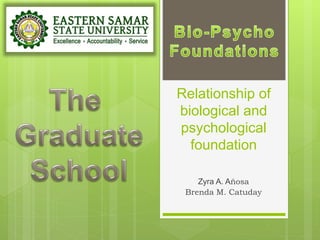
relationship_bio_psycho.pptx
- 1. Relationship of biological and psychological foundation Zyra A. Aňosa Brenda M. Catuday
- 2. BIOLOGY • a natural science concerned with the study of life and living organisms, including their structure, function, growth, origin, evolution, distribution, and taxonomy. https://www.visiblebody.com/learn/biology
- 3. PSYCHOLOGY • a branch of science which studies the activities of the organism. • Psychology is the science of mind and behavior and its functions, especially those affecting behavior in a given context. It includes the study of conscious and unconscious phenomena, as well as feelings and thought.
- 5. THE LEARNING PROCESS & THEORIES OF LEARNING
- 6. HOW DO PEOPLE COME TO BEHAVE IN THE WAY THEY DO?
- 7. WHAT IS LEARNING? LEARNING is any change in a person or his behavior. (Burton) LEARNING is modification of inherited responses and the acquisition of new experiences. (Freeman)
- 8. WHAT IS LEARNING? LEARNING Is the modification of the reaction of the organism through experience. (Covin)
- 9. WHAT IS LEARNING? LEARNING Is any change that may take place in one through the influence of the outside world, whether the influence be persons or things, good or bad. (Thomas)
- 10. OUTCOMES OF LEARNING • Knowledge and Information • Habits and Skills • Attitudes and Appreciation
- 11. THEORIES OF LEARNING 1. Connectionism Theory (Thorndike) Association is established between stimulus and response. Practice strengthens the association between the stimulus and response. The connection between stimulus and response is strengthened by reward of satisfaction.
- 12. THEORIES OF LEARNING 2. Classical or Respondent Conditioning (Ivan Pavlov) – the association between a conditioned stimulus and a response is strengthened by repeated presentation with the unconditional stimulus.
- 13. THEORIES OF LEARNING 2. Instrumental or Operant Conditioning – the stimulus – response pattern is strengthened by immediately following the response with the reinforcing stimulus.
- 15. FACTORS AFFECTING LEARNING 1. Motivation – the stimulus-response pattern is strengthened by immediately following the response with the reinforcing stimulus. 2. Reinforcement – may be made through the use of audio-visual aids, review, drills and other means.
- 16. FACTORS AFFECTING LEARNING 3. Extinction – let something die out of be forgotten by disuse. 4. Association – means the more connections are made with a subject, the better it will be learned and retained.
- 17. FACTORS AFFECTING LEARNING 5. Interest – facilitates learning and be its own motivation. (interesting lesson). 6. Reward or Punishment – should be given immediately.
- 18. FACTORS AFFECTING LEARNING 7. Recency – means that learning should be made recent in the minds of learners so that they will not forget what they have learned. (frequent review)
- 19. KINDS OF LEARNING Direct Experience – learns through a direct contact with the stimulus. (Pilsbury). Indirect Experience – uses mode, tools/instruments in order to learn something (Pilsbury).
- 20. KINDS OF LEARNING Congenital – present at birth such as reflex actions (Burnham). Temporary – learns (needed) in a short while and conveniently forgotten (Burnham). Permanent – those that be utilized throughout life (Burnham).
- 21. KINDS OF LEARNING Sensory Learning – learns through the sense of touch - Braille reading (Ruch). Verbal Learning – memorizing poem. (Ruch). Motor Learning – Typing or swimming (Ruch).
- 22. KINDS OF LEARNING Ideational Learning – planning the plot of the story (Ruch). Attitudinal Learning – teaching good manners. (Ruch).
- 23. IMPLICATIONS FOR EDUCATION Management of Learning • People learn in different ways. Teachers should, therefore, use different strategies in teaching. • Parents and teachers should help children develop good study habits by supervision.
- 24. IMPLICATIONS FOR EDUCATION Management of Learning • Since learning is habit formation, there should be no exception to following the rules of good study habits. • Drill often on those things that should be automatized or those that will be needed throughout life.
- 25. IMPLICATIONS FOR EDUCATION Management of Learning • The learning of any fact or information will be easier the more it is associated with other things. Recall will also be easier. • Frequent review will prevent forgetting.
- 26. Theories of the relationship between body and mind: • Aristotle, who conjectured that the two exist as aspects of the same entity, the mind being merely one of the body’s functions.
- 27. Theories of the relationship between body and mind: • French philosopher Rene Descartes, both the mind and the soul are spiritual entities existing separately from the mechanical operations of the human body.
- 28. Theories of the relationship between body and mind: • The psychological parallelism theory of German philosopher Gottfried Wilhelm Leibniz believed that mind and body are separate but that their activities directly parallel each other.
- 29. Behaviourists such as American psychologist, John B. Watson - focused on observable human and animal behaviours and their relationship to the nervous system.